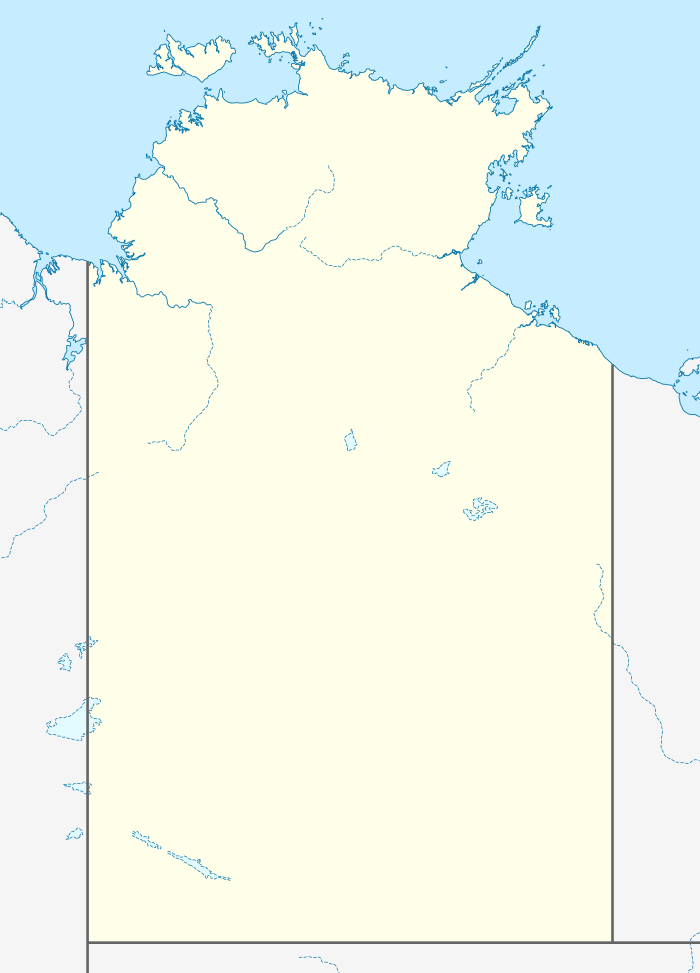Angurugu, Northern Territory
| Angurugu Northern Territory | |
|---|---|
 Angurugu | |
| Coordinates | 13°57′32″S 136°26′56″E / 13.95889°S 136.44889°ECoordinates: 13°57′32″S 136°26′56″E / 13.95889°S 136.44889°E |
| Population | 882 (2006)[1] |
| LGA(s) | East Arnhem Region |
Angurugu is a community located on Groote Eylandt in the Northern Territory, Australia, just off the mainland. The main languages spoken there are Anindilyakwa, an Australian Aboriginal language, and English. A permit is required before travelling to Angurugu.
Climate
| Climate data for Angurugu | |||||||||||||
|---|---|---|---|---|---|---|---|---|---|---|---|---|---|
| Month | Jan | Feb | Mar | Apr | May | Jun | Jul | Aug | Sep | Oct | Nov | Dec | Year |
| Record high °C (°F) | 41.7 (107.1) |
38.9 (102) |
38.6 (101.5) |
37.2 (99) |
36.4 (97.5) |
34.0 (93.2) |
34.6 (94.3) |
34.9 (94.8) |
37.4 (99.3) |
39.8 (103.6) |
39.7 (103.5) |
39.6 (103.3) |
41.7 (107.1) |
| Average high °C (°F) | 33.1 (91.6) |
32.3 (90.1) |
31.9 (89.4) |
31.5 (88.7) |
30.2 (86.4) |
28.3 (82.9) |
27.6 (81.7) |
29.0 (84.2) |
30.9 (87.6) |
32.8 (91) |
33.9 (93) |
33.7 (92.7) |
31.3 (88.3) |
| Average low °C (°F) | 24.6 (76.3) |
24.6 (76.3) |
23.7 (74.7) |
21.9 (71.4) |
19.9 (67.8) |
17.2 (63) |
16.2 (61.2) |
16.4 (61.5) |
17.7 (63.9) |
20.1 (68.2) |
23.3 (73.9) |
24.5 (76.1) |
20.8 (69.4) |
| Record low °C (°F) | 17.2 (63) |
17.4 (63.3) |
14.4 (57.9) |
13.6 (56.5) |
8.9 (48) |
2.2 (36) |
2.7 (36.9) |
5.0 (41) |
6.7 (44.1) |
9.4 (48.9) |
13.4 (56.1) |
14.7 (58.5) |
2.2 (36) |
| Average rainfall mm (inches) | 238.1 (9.374) |
249.6 (9.827) |
314.7 (12.39) |
152.2 (5.992) |
37.6 (1.48) |
8.9 (0.35) |
2.2 (0.087) |
1.5 (0.059) |
4.5 (0.177) |
31.3 (1.232) |
87.0 (3.425) |
158.7 (6.248) |
1,287.8 (50.701) |
| Average rainy days (≥ 0.2mm) | 14.9 | 14.4 | 16.3 | 9.4 | 4.4 | 2.0 | 0.7 | 0.6 | 1.0 | 2.9 | 6.9 | 10.7 | 84.2 |
| Source: [2] | |||||||||||||
History
Angurugu was the site of a Christian mission operated by the Church Missionary Society. The mission was originally located on the Emerald River. It was established between 1921 and 1924 "as a place for isolating and training children of mixed descent" (i.e. part-Indigenous and part-non-Indigenous). It ceased to be a 'half-caste' mission in 1934 and was shifted to Angurugu in 1943.[3]
References
- ↑ "LGWORKS local government database". LGWORKS. Retrieved 2007-03-02.
- ↑ "Angurugu". Climate statistics for Australian locations. Bureau of Meteorology. Retrieved 30 March 2014.
- ↑ Harris, J. W. (1998). We wish we'd done more : ninety years of CMS and aboriginal issues in North Australia (Rev. ed.). Adelaide: Openbook.
External links
This article is issued from Wikipedia - version of the 10/14/2016. The text is available under the Creative Commons Attribution/Share Alike but additional terms may apply for the media files.